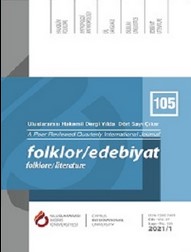Güney Sibirya Türklerinin Halk Anlatılarında Dönüştürücü Bir Güç Olarak Rüzgâr
Wind As A Converter Power in Turkish Folk Narratives
Author(s): Fatma Zehra UğurcanSubject(s): Customs / Folklore, Studies of Literature, Turkish Literature
Published by: Uluslararası Kıbrıs Üniversitesi
Keywords: wind; mythology; beliefs; Turkish mythology; Turkish beliefs; folk narratives;
Summary/Abstract: Air has been an important issue because it is a vital source of human. Many beliefs about weather and wind developed in ancient philosophy, mythological perceptions and celestial religions. In many of these imaginations, the wind is a divine sign. Similarly, when we turn to Turkish mythology, we encounter beliefs that the wind is dominated by gods and spirits. The Turks; the names such as “Yel Baba”, “Yel İyesi” believed that the souls they gave were the forces controlling the winds. These emerging beliefs have influenced not only social life but also folk literature. Indeed, mythological elements are treasures that enrich literature. In this context, it can be said that wind, which is an important part of mythological perceptions, frequently finds a place in the narratives. Wind is a phenomenon that positively directs the fate of the hero with a sacred touch in narratives and can transform the hero. However, we rarely witness that the wind brings negatives to heros and even the wind is the representative of evil beings. Regardless, there is a fact that the perception of wind is always associated with supernatural beings and is a decisive mystical element in the narrative. This study focuses on the meaning of philosophy, mythology, heavenly religions and sufism in order to illuminate the origin of the phenomenon of wind in the narratives. In order to support the ideas put forward in this study, the Altai epic from the South Siberian geography, “Maaday-Kara”, Shor epic “Altın Tayçı”, the Shor tales “Kayıp Kız” and “Şanssız Nekker”, the Hakas tale “Işık Işıkoğlu Hakan” and “Akkız and Karakız” from the Anatolian field will be examined. The aim of the study is to determine to what extent and how the reflections of wind imagery in Turkish mythology and cultural structure are reflected in folk narratives, and what functions they perform in the narratives.
Journal: Folklor/Edebiyat
- Issue Year: 27/2021
- Issue No: 105
- Page Range: 69-80
- Page Count: 12
- Language: Turkish

